
Postelsia palmaeformis
Sea Palm
Interacted with at: Botany Bay, Juan de Fuca Strait, British Columbia, Canada
29 May 2021
Time at site: 10:05am to 11:20am PDT.
Low Tide: -0.3 feet (measured at Sheringham Point Tidal Station)
Weather: Mainly clear (less than 5% cloud cover), wind SE 5 to 10 km/hour, sea light chop with moderate SW swell, surf crashing on rocks, temperature 12˚C, relative humidity 84%.
Phase of Moon: Waning Gibbous (approx. 78 hours into this phase at time of collection); (Previous Phase, Full Moon, 26 May 2021 at 4:13am PDT: Next Phase, Third Quarter, 2 June 2021 at 12:24am PDT.)
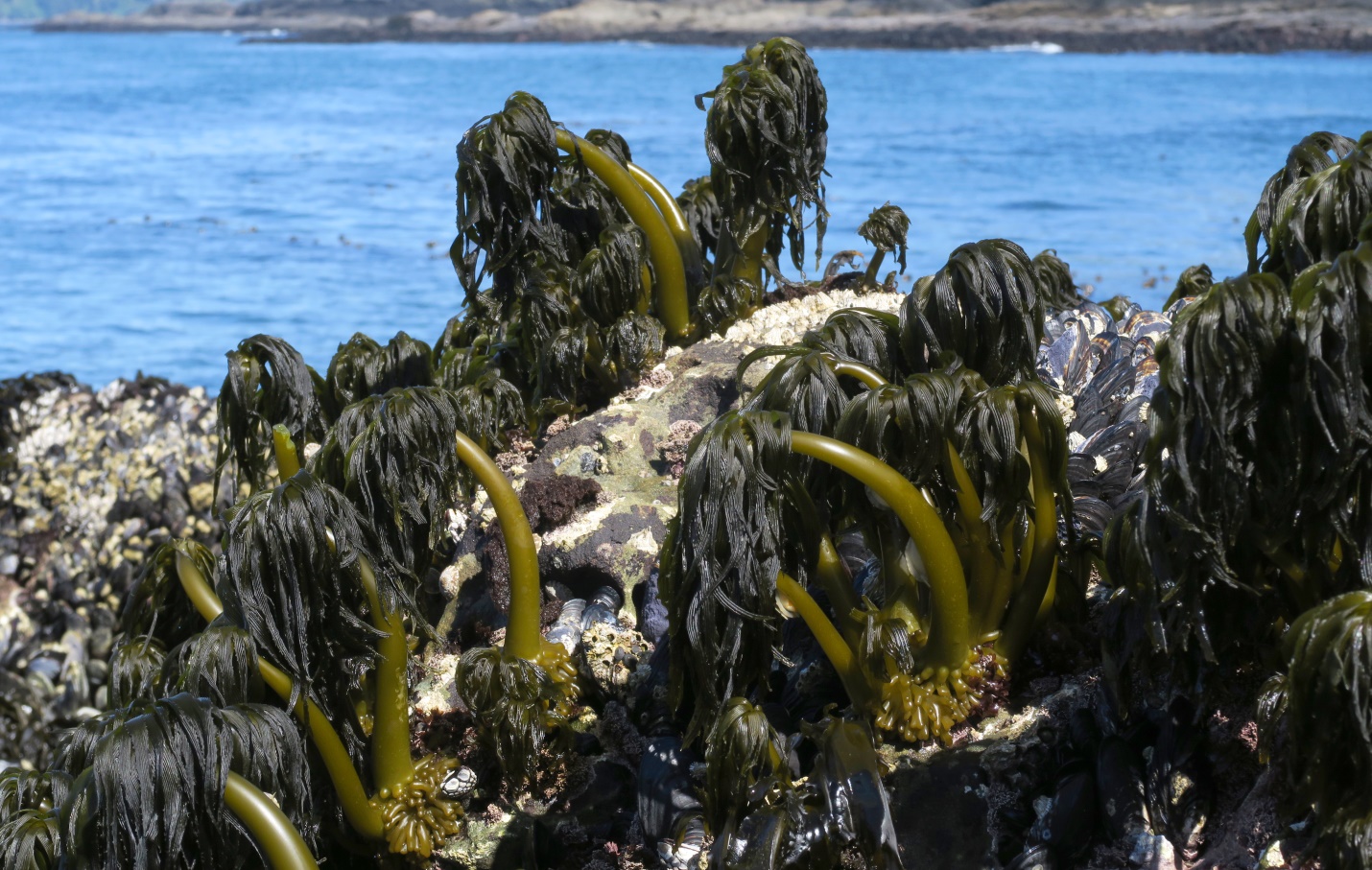
Figure 1: Postelsia palmaeformis, common name Sea Palm – shown here atop a limestone outcrop on a very low tide in late spring. Largely inhabiting the upper intertidal zone, this distinctive kelp grows exclusively in highly wave exposed areas. Botany Bay, Strait of Juan de Fuca, BC, Canada. May 29, 2021. Photo ID 27181 ©Seaweedwhisperings.com
In situ observations:
We interacted with this seaweed on a surf-swept rocky outcrop on the exposed shores of Juan de Fuca Strait. Observation was timed carefully to low tides and light seas; in other conditions it is simply too dangerous to be in this location. The general area of Botany Bay hosts an exceptionally abundant and diverse array of seaweeds and marine invertebrates. Even in such a rich environment Postelsia grows and persists in only a few locations – those with the highest wave exposure.
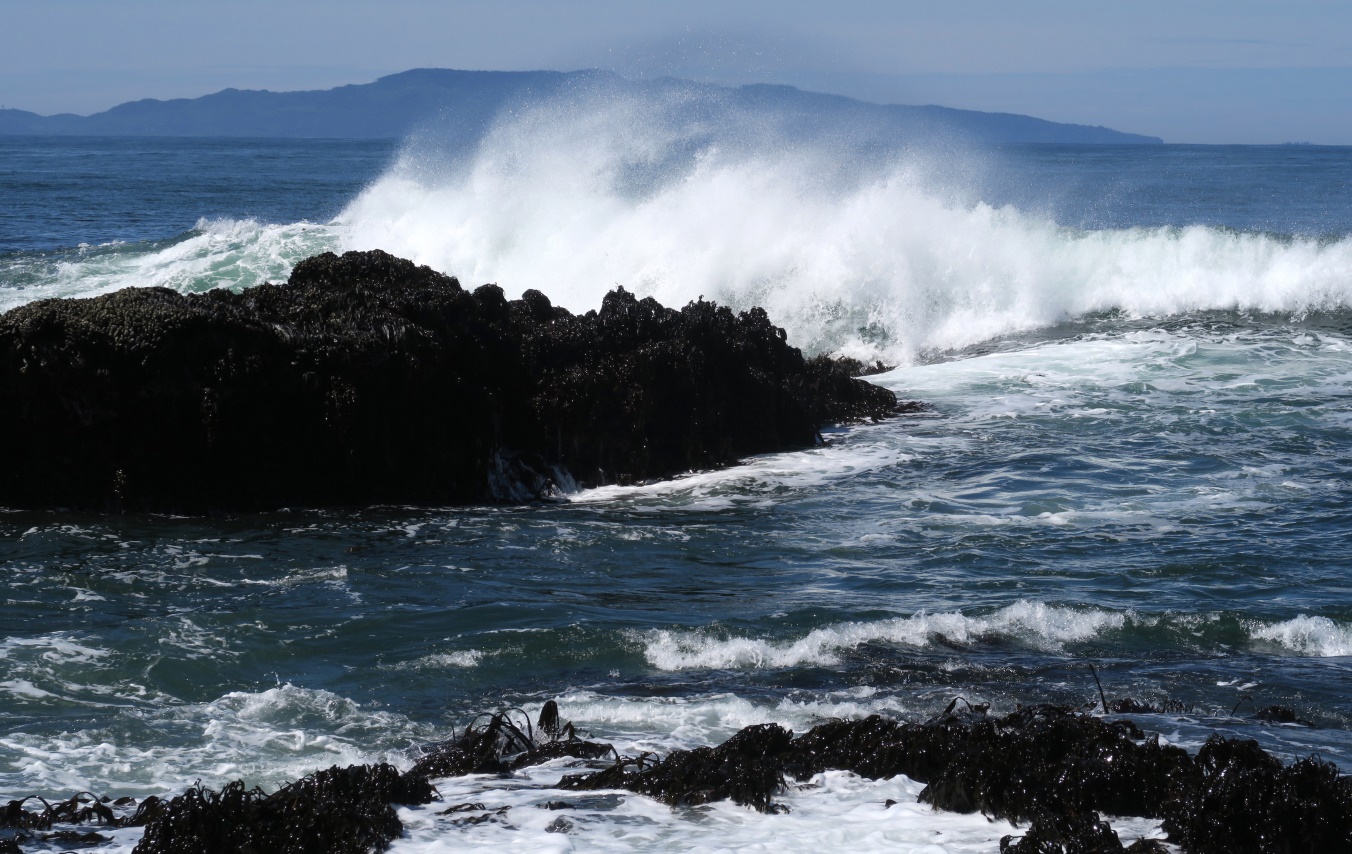
Figure 2: Surf action in Sea Palm habitat is depicted here, resulting from only moderate southwest ocean swells. Postelsia palmaeformis, frequently ‘enjoys’ wave action much more dramatic than this! Sea Palms manifest as a truly remarkable algal-life expression. Botany Bay, Strait of Juan de Fuca, BC, Canada. May 29, 2021. Photo ID 27182 ©Seaweedwhisperings.com
Person 1:
They grow atop highly-exposed and surf-crashed rocks. How do you survive and not break when so often pounded?
Indeed, looks like a palm, with a tall branchless stem and a mop-top of “fronds”.
Holdfasts knobby and tough. I can’t pull a seaweed off of the rock even with a strong pull.
Clusters of 100-200 plants.
Blades are frayed towards the tips but it looks like they can keep growing from the stipe end.
Stipes are thick but extremely flexible. Can be bent back 180 degrees without any indication of snapping.
Strongly resists being bent.
There are limpets on many of the stipes but the stem doesn’t look grazed. Perhaps the limpets move up to the blades to forage there when the tide comes in.
The tide is very low today and the surf is not huge.
The Sea Palms are resting lazily, waiting for the tide to rise and the surf to return.
I recall from previous visits that they appear to enjoy playing with the surf.
Perhaps they’re a bit impatient while waiting.
They’re relaxed, conversing casually amongst themselves.
They are in a group but not tangled.
Bright yellow-green coloration.
Broke off a blade to taste. Couldn’t chew it – it didn’t break up in my teeth. No discernable taste or smell.
When I jiggled a stipe the mop-top tossed its “hair” wildly in all directions.
I interrupted my seaweed interaction to write some bird notes – does this seaweed get distracted? Hard to maintain concentration? I don’t feel distracted.
Unlike many other seaweeds, this one doesn’t seem to have hitchhikers attached to it – just the passing herbaceous limpets.
Stipe is extremely smooth and shiny – I think this design reduces drag in the surf.
Palm-like appearance attracts and commands attention.
Stipe in cross section is fairly solid, but is hollow in the center.
Person 2 had broken off a Sea Palm and was ruffling the blades right under her nose – she invited me to try this out – smells like the freshest of fresh air.
Alone at the top, no other kelps grow there.
Confident in its location; doesn’t feel threatened.
Sea Palm, “palm” – visions of a tropical seaside resort.
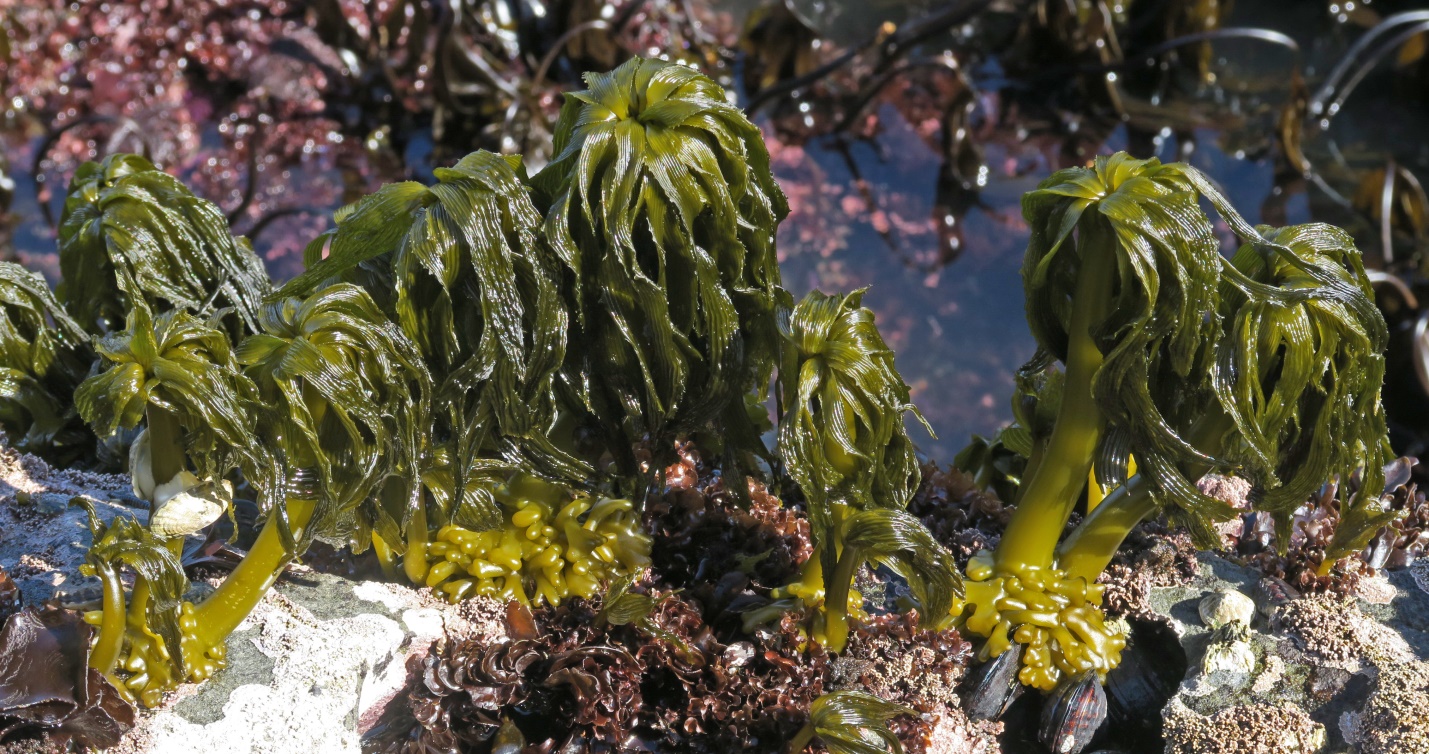
Figure 3: A grouping of Postelsia palmaeformis, Sea Palms, growing on the edge of a rock outcrop. Several varieties of red seaweeds and some other kelp species grow below and behind this grove of palms. And at their ‘feet’ the Sea Palms compete with mussels, coralline algae and barnacles for a foothold. Botany Bay, Strait of Juan de Fuca, BC, Canada. May 29, 2021. Photo ID 27183 ©Seaweedwhisperings.com
Person 2:
Sea Palm “colony”, you grow at the top of this sandstone outcrop that extends its long slender finger into the open waters of Juan de Fuca Strait.
You’re at the top AND cleverly positioned just so – JUST over the topmost portion of the rock topography possibly so that your holdfasts can clasp areas not directly buffeted by waves.
But your thick succulent looking stipes grow up tall enough that your blade cluster is up right where the wave action is (no rocks to shield them). Oh, they must swing around in a glorious swirl of algae and frothing ocean waters. And at lower tides your blades catch the spray of swells crashing against the very rocks you grow on!
Your holdfast looks thick and succulent like your stipe and is the same color – a lovely yellow-olive-green and the ‘branches’ of your holdfast mainly end in bluntly rounded forked tips. They look like happy to be bare-footed toes – but in this location that you love to grow they actually have a very serious job.
Can you do difficult jobs with ease?
Make it look easy?
I think so!
You also create/live together in groupings; you truly enjoy your fellow kind, like each other’s company and share your real estate.
Your blades are numerous, easily 50 or more (to a single stipe).
The blades drape down limply when out of water.
They have ridges which form parallel lines the entire blade length, and also have small teeth or serrations along the outer margins.
The blades are a much darker green than the holdfast and stipe and the total effect is indeed rather like a miniature “palm tree”.
The lines and slightly rough edges of your blades catch the light and give you a certain “look”, a style and a particular beauty.
Tips of your blades are darker – they are drier and more tattered, but that isn’t seen unless you really look closely.
Your stipe arches – curves somewhat to very much. This lends an air of causal competence, not any hint of carrying a burden.
In this colony there is a variation of sizes of individuals. Some small “baby” palms are only 3cm tall, many are about 20cm tall and the largest are 30cm tall.
I think you all started growing just this year – an annual that LOVES a very special intertidal place, high intertidal but also very wave swept!
So, you can be very choosy. You know what you like and quite simply nothing less will do.
Here now at low tide it feels like you are waiting – expectant and ready.
You’re fine with waiting because when you are not waiting you enjoy the pinnacle of play with the surf.
How long, I wonder, would it take to refresh your desiccated blade tips? Maybe you don’t bother – maybe they just break off but you keep growing them from their origin at the top of your stipe. Yes, that would work just fine!
Easy. No problem.
Bare feet. Laid back.
Something is lost? No problem – there’s more where that came from!
A laid back confidence borne from certainty of ability and abundance.
I tried to take a sample of this seaweed to taste it.
The stipe will bend way over, doubled back in a tight “U” and would not break until I exerted considerable force on the bend.
Strength through flexibility!
Observing the broken stipe, I can see it is hollow at the core and the sidewalls are 2 – 3mm thick (the overall diameter is 7cm at this cross section and the hollow was 2cm wide).
Bite it – very nice crunch, but little flavor.
Ate one blade; it too had little taste and is surprisingly rubbery.
I touched the seaweeds – it’s fun to play my fingers through their blades but Sea Palm doesn’t like me touching it! If any head shaking and tress flinging is going to happen it will be at the will of Sea Palm itself, not by some outside influence. Sea Palm is the one in control.
Also, if I move the blades much I sense I’d only aid the wind and sun’s desiccation and I don’t want that – quite the opposite, I want this colony of amazing seaweeds to thrive!!
Smell – I put the top of one plant to my nose; no smell was apparent, so I inhaled more deeply through the cluster of blades while twirling them under my nose. Super fresh air is the smell – better somehow than the freshness of the air alone (which is pretty grand here today).
“Postelsia” – “post”-elsia…, stipes stand upright, with a bit of a curve, like fence ‘posts’ in the ground. Postelsia, to say the word it has a clear, clean and not overly embellished sound – this fits the seaweed which lives in the roughest of intertidal areas and is as such nothing but the essentials are a part of this alga. It’s simple, clean, washed fresh, not complicated, yet attractive.
“Palmaeformis” – the entire seaweed, from its hold fast to its drooping blades resembles very much a tropical palm tree. So, yes, certainly an apt name –in the form of a palm!
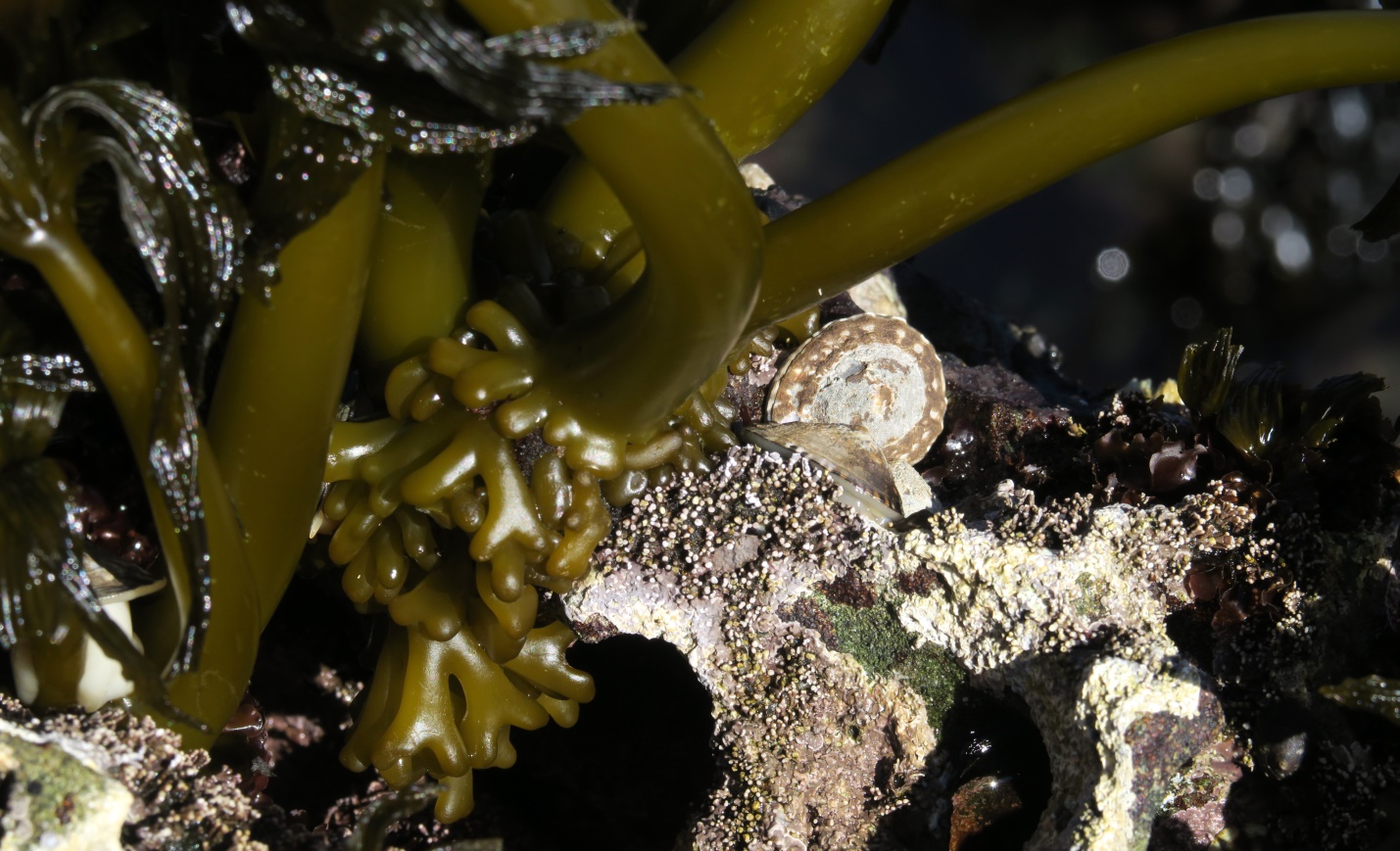
Figure 4: Postelsia palmaeformis – this image details the stipe bases and holdfasts of several Sea Palm individuals, all affixed closely together to the sandstone substrate. Botany Bay, Strait of Juan de Fuca, BC, Canada. May 29, 2021. Photo ID 27184 ©Seaweedwhisperings.com
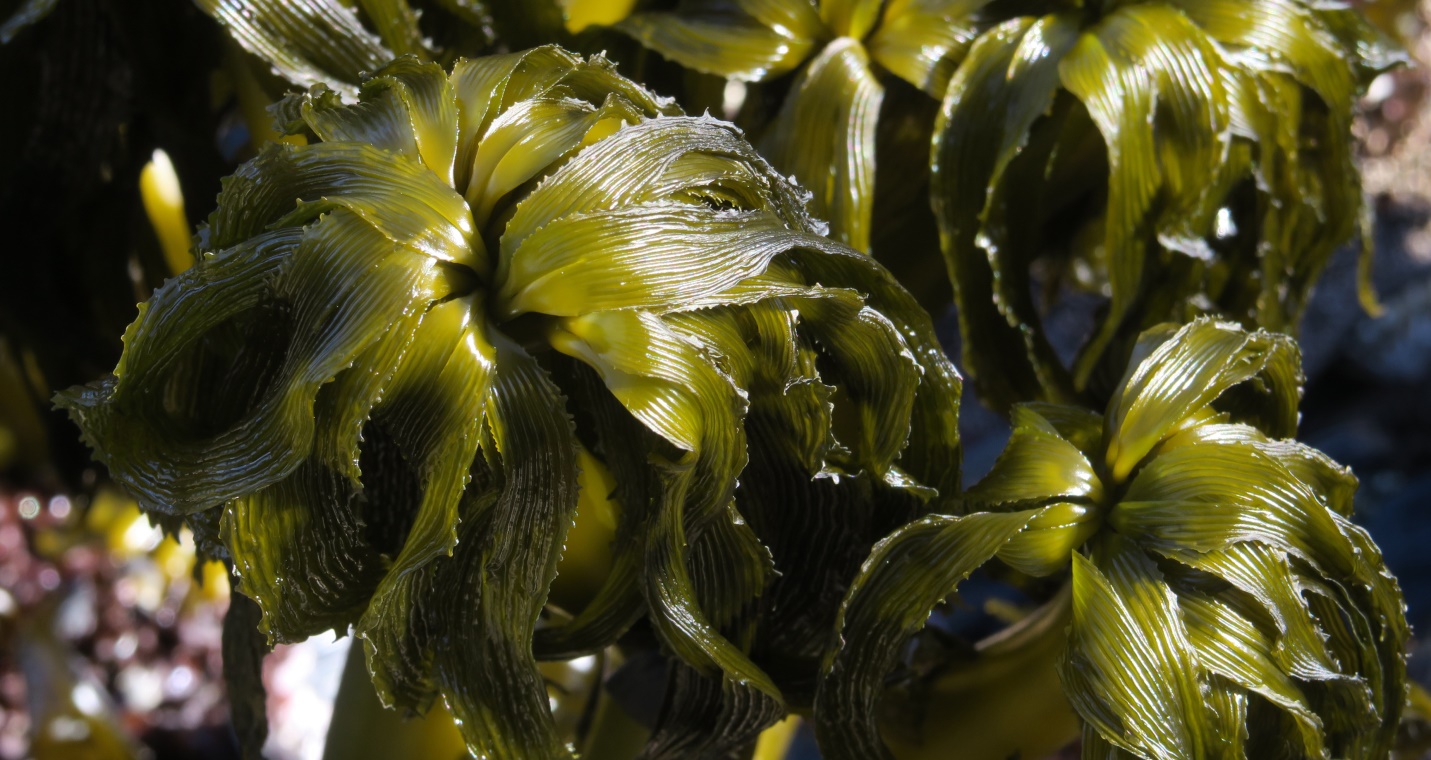
Figure 5: Postelsia palmaeformis, Sea Palm – closer view reveals the parallel grooves and dentate margins of the blades. These grooves serve a significant function in spore release and continuing generations of this alga. Botany Bay, Juan de Fuca Strait, BC, Canada. May 29, 2021. Photo ID 27185 ©Seaweedwhisperings.com
Further Observations & Impressions:
This is a very interesting seaweed! It is admirable!
Postelsia exudes an aura that commands attention. In it is a most interesting mixture of excellence and competence to the point of mastery that it is presented with a comfortable, casual and total confidence.
Person 1 envisioned going to see a spiritual leader, someone who has this aura, you’re drawn to it - not because of fame, not because of what they do, but because of who they are. Person 2 had the concept of a lighthouse, its beacon shines and is an important guide to mariners in need of orientation/direction.
Within their domain/realm/areas of interest or activity or expertise, it is quite literally next to impossible to be better than the Postelsia person. We explored whether we could sense Postelsia experiencing envy in comparison to others, but found none of that. It quite simply is the unique reality that within their given realm there is simply no way to be better/do better than Postelsia does.
Does this seaweed flaunt danger? No, it’s more that it’s confident to stand up in the face of danger. Confident in its location; doesn’t feel threatened. BUT needs that position? This isolates Postelsia from almost everyone else, and it demands that Postelsia not grow lazy, not in the least. Postelsia needs to keep flexible, strong and vigilant to retain its stature.
During this interaction, there were many expressions of the peak of wealth. Most of our thoughts were related to male persona having achieved financial and social prominence, with plenty of “down time” to relax and ostensibly enjoy life. Person 2 had another take on this – while admiring the palm-like expression of Postelsia the Sea Palm, Person 2 envisioned palm trees, tropical resorts, and happy bare-footed beach-goers. A song came to mind - “Don’t Worry, Be Happy” by Bobby McFerrin. This song is written from the perspective of one who has little in the way of material comforts or security - this seems like the opposite circumstance of how we’d been viewing Postelsia thus far. So, is there another kind of laid back confidence and way of life that also enjoys much down time that is borne from a type of abundance that is not material? Abundant generosity of spirit, abundant creativity, abundant loving family and community, abundant contentment and laughter, proximity to sufficiently abundant resources – basically any abundant opportunities for peak expression.
Within a Postelsia colony, a range of sizes was noted, BUT they all look the same otherwise. This is like an organized crime mafia group; you are molded from birth to have the same values. It doesn’t matter if you’re small, big, the boss, the enforcer, whatever, you all embody the same values and conformity is demanded. Postelsia persons too may find it most comfortable to live within ‘groups’ that have little variation in their core values.
With this seaweed we had the thought that if you land in the right spot, you’re almost assured of a favorable place in life. In humans, if you have the benefit of being born into circumstances of advantage you also have a head start at success.
This seaweed lives in groups or colonies - in a group, but not tangled. They maintain personal independence, they don’t get enmeshed. They can dance well around the energy of their like seaweed companions and that which is independent in this seaweed is rarely outwardly revealed. What does the colony give them, why are they not loners? They RELY on others, they are NOT self-sufficient. At the top and in a group. Cooperative, not much competition – a club of like individuals. You’re all at the same level, have nothing to prove, abundance is there to enjoy. However, the group has a size limit (very specialized habitat) and no other kelps “are admitted” in this place.
We paused to consider, is this energy mainly cooperative or how much competition must be involved to be at the top? We concluded that to be in this place of effortless confidence there is a balancing going on between cooperative and competitive drives. Gyroscope comes to mind - in this device we have the themes of: free to alter direction, orientation not affected by tilting forces, provides stability and balance. A lot of action is happening in a gyroscope on a ship at sea (or a Sea Palm atop a wave swept rock) but the overall result is steadiness – I’m here, I thrive, I prosper!

Figure 6: Ideal habitat? For Postelsia palmaeformis the answer is, yes, it most definitely is! Botany Bay, Strait of Juan de Fuca, BC, Canada. December 3, 2021. Photo ID 27186 ©Seaweedwhisperings.com
Pinnacle of play – with the surf. What is this distinctly Postelsia experience? It’s a deep satisfaction about engaging totally and successfully with the elements. Excitement, exhilaration, elation – all felt within. There is no need to outwardly express these feelings; the energy resonates and internally nourishes.
Typical of this state is that to remain at the top you are constantly tested. There is a group association that supports the success and underscores the confidence. To remain confidently relaxed – “don’t worry be happy”, where Postelsia lives requires some unique abilities. In seaweed terms, the pounding waves have washed away everything that is not essential, leaving the shining core of flexible strength and the innate power of truly thriving!
Postelsia has an outward flexibility, however, it is not flexible about where it thrives. The range of conditions it tolerates is very limited. There is little possibility to explore more widely. Postelsia needs its position; it has a very limited life comfort zone; there is little room to maneuver in this regard. That position isolates Postelsia from most others, and it limits them, too. So strength through flexibility in this seaweed’s energy is specific to very certain realms of endeavor. Outside those realms they certainly cannot thrive and they may not even survive.
In your way of being, Postelsia, the world needs to fit into the way YOU think, rather than you looking to adapt your own thinking. You’ve found “a” method/strategy/view point that works…, and it is to you “THE” method. You’ve come to this certainty through experience – the surf pounds away anything extraneous! Any outside criticism or ‘suggestions’ for improvement are considered, but rarely incorporated; it seems that the certainty Postelsia possesses is self-earned.
There can be a ‘fixed’ quality to the casually competent demeanor of this energy. It therefore rather difficult to get to know the identity of Postelsia. The outsider has to try many times to find Postelsia’s authentic being. One could easily give up trying. Postelsia prefers that, prefers to be private about its real self and most certainly doesn’t “wear its heart on its sleeve”.
Also, in attempting to become familiar with Postelsia, others have to step far out of their normal environment or comfort zone – just like field guides warn that when you observe Postelsia palmaeformis in its environment you must be careful to never turn your back to the dangerous ocean swells. An outsider can be interested in doing this in spite of the danger – something about the Postelsia energy is like a “beacon” or a lighthouse shining out to sea. It doesn’t seem to just warn of hazards, it seems to convey an implicit strength that is compelling.
Noting that there can be both flexibility and rigidity and that there can be both cooperation and competition illustrates that there are bifurcations in this seaweed’s energy. For example, we’d identify a concept and soon after two separate threads would develop. These bifurcations were seldom reconcilable, but interestingly arose from the same source.
Postelsia appears as if they can handle most anything really easily but as we worked with expressing the fullness of this energy we could see that what Postelsia does is actually very difficult. Recognizing the bifurcations in our “going deeper” expressions was one thing, holding them each as valuable and distinct, well, that was quite another thing. In many cases we made an attempt to figure out how one thought related to this other thought that seemed to have originated from a common ‘ancestor’. This process was both challenging and tiring. It proved generally unsuccessful to assign connections among the bifurcated ideas. We conclude that that is the precise point! The bifurcations need to exist independently. They each have value.
So, is this really an ability of Postelsia that is one of its strengths? To quickly and easily understand or intuit or rationally know of differences, discrepancies, distinctions, disparateness – basically any and all manner of expressions of this bifurcation quality. It seems to be that in the Sea Palm life experience awareness of all these possibilities naturally imparts a way for Postelsia to eliminate any weakness or vulnerabilities to their position? It also can impart a relaxed and contented nature; there’s no struggle to make things different.
It is significant to note that once Postelsia cannot masterfully embrace all its known bifurcations this is the point at which it weakens, disintegrates and dies.
Their upright posture combined with being situated high in the intertidal zone, means that Sea Palm has a life of intense extremes. They can be totally engaged with the crashing surf, and then with just enough drop of the tide, they are suddenly motionless and at rest. Tide changes occur four times a day and consequently Postelsia faces this bifurcation in activity endlessly. One could ask, well, don’t all kelps experience this? Actually, no, not at all. The other kelps live in the lower intertidal zones and are rarely exposed and almost never fully exposed above water as Postelsia routinely is.
In its prime, this seaweed is finely balanced in its environment. While needing to compete for space to grow it simultaneously contributes by providing shelter, shade, and hydration to lower growing seaweeds and marine invertebrates at its feet. Postelsia also balances ‘intolerance towards’ with ‘benefit received’ from nearby growing turf algae, barnacles and especially mussels. Postelsia thrives on bare rock, so they can assume their position atop the rock only if barnacles or mussels give way, yet the newest beginnings (gametogenesis) of Postelsia receive shelter in their early lives from those same mussels and barnacles. Sea Palms have this complex relationship then, cooperation and competition, with their nearest ‘other species’ neighbours.
It may look easy to an outsider, this life lived at the top, but if one who is at the top slips from their lofty position, well, then they’re gone! Within their group (club) they’re either with them at the top or they are no longer relevant – they cease to exist, disappear from the top, die.
The shadow side of Postelsia energy may involve impatience and boredom, and a lack of tolerance. Certainly as one of the various species of kelp, this seaweed is considered by many as being very special. It has an ‘elite’ quality and it keeps company with only those who can thrive as boldly they do.
Somewhat related to the boredom issue might be a lack of, or stagnation in, individual growth due to inadequate stimulation; sameness can be numbing and weakening. What isn’t challenged won’t grow. For Sea Palm the challenge that can keep them healthy is the amazing power of the pacific surf. Druehl and Clarkston in “Pacific Seaweeds” cite that locations where Sea Palm grow have water velocities possibly exceeding 14 meters per second and accelerations that may pull in excess of 41 times the pull of gravity. Without the need to meet those forces, Sea Palm would not grow and stay ‘fit’ and certainly it would not thrive. Postelsia can’t stay at the top unless consistently engaged in testing itself to the utmost. In top form Postelsia needs to be able to find fulfillment and challenges, both at times of peak engagement and also in the ‘rest-period’ of the routine intervals that always come in between.
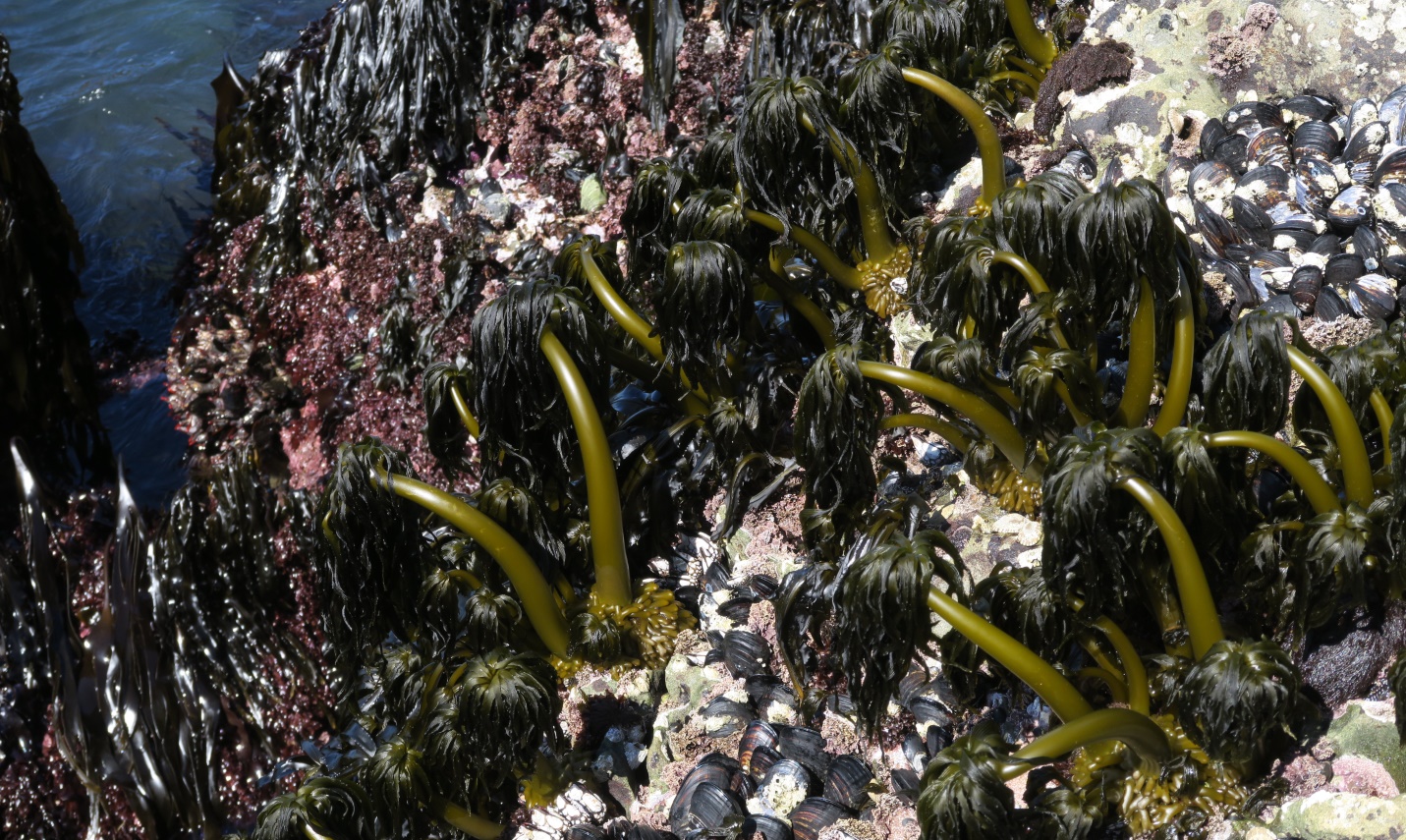
Figure 7: Postelsia palmaeformis – a grouping of Sea Palms affixed to the rock edge here are growing in the company of California mussels, gooseneck barnacles and some coralline algae. In the channel below this “palm grove” other kelps including Lessoniopsis littoralis, Strap Kelp, can be seen growing in their suitable tidal “tier”. Botany Bay, Strait of Juan de Fuca, BC, Canada. May 29, 2021Photo ID 27187 ©Seaweedwhisperings.com
Biology & Natural History Information:
Habitat:
Postelsia palmaeformis is an annual kelp that has a patchy distribution but is locally abundant on exposed rocky habitats of the high to mid intertidal zones. During the summer dense stands of this alga – which rather strikingly do resemble miniature palm trees, can be found on the most wave-exposed headlands along the outer coast. By late November (in Washington state, USA) these distinctive kelp have usually disappeared for the year, ripped out by intense winter storms.
Description:
Thallus to 60cm tall, erect, annual. Holdfast compact, composed of stout, branched haptera. Stipe is thick, tubular, thicker at the base than at the apex; it is both erect and resilient (one source describes Postelsia as “robust” stating that it is capable of bouncing back like an elastic band with every wave.) At the upper tip of the stipe numerous branches are arranged radially; each branch carries a single drooping blade. A single plant may have 100 or more of these long, narrow blades. The blades are strap-like, have dentate margins, and both surfaces have parallel groves along the entire length (the grooves of one surface alternating with those of the other.) Blades can reach up to 40cm long and are olive green in color. As Sea Palms age, they take on a more yellowish-brown shade.
This Kelp differs from other members of the Laminariales in several distinct ways. It has no pneumatocysts (air-filled bladders). Its gametophytes can mature and produce gametes even in the absence of blue light or added iron in the medium, two conditions found to be necessary for gametogenesis in other marine brown algae inhabiting cold/polar seas.
Postelsia has adapted a unique spore release method suited to the tumultuous conditions of the extreme wave swept areas in which it thrives. In late spring spores are released into the grooves of the drooping blades when the Sea Palm is exposed at low tide. Surf spray washes the blades before the return of the actual tide and spores drip down the neatly grooved ‘runways’ from the slender blade tips to the underlying substrate where they adhere quickly – before the return of the next high tide or onslaught of high surf. Most spore dispersal is limited to distances of 1 to 5 meters. Long-distance dispersal is probably only effected by floating individuals that have been torn from their substratum. Within a clump, the individuals are siblings.
Postelsia palmaeformis is often found growing exclusively in locations where the shoreline is frequently buffeted by heavy surfs and it is exposed to extreme wave shock. The bivalve, Mytilus californianus, (California mussel) also favors this kind of extreme intertidal splash zone. Sea Palm colonizes patches of rock bared by the removal of mussels by predators, storms or drift logs. Postelsia can also overgrow barnacles, mussels or turf algae, causing them eventually to be ripped off the rock and providing new sites for Sea Palm settlement, but Sea Palm’s most stable and dense populations are within the bare patches of mussel beds. One study showed that the microscopic Postelsia gametophytes establish themselves within mussel beds which then prove highly satisfactory for germination and protection from wave exposure. Without subsequent disturbances to the dominant mussel population, however, the Sea Palm sporophytes would not have sufficient space to grow.
The Sea Palm is a protected species and it is illegal to harvest this seaweed in British Columbia, Washington and Oregon. In California recreational harvesting is illegal but commercial harvesting remains licensed and legal. Considered a delicacy, this seaweed could be better protected by regulating time of harvest as at certain seasons clipping blades for harvest limits the sporophyte’s ability to produce spores and thereby contribute to subsequent populations.
The blades of Sea Palm are among those of the highest fibre content, about 65%, which is considerably more than dulse and for this reason many people believe eating them promotes digestive health.
Postelsia palmaeformis is named after an Estonian naturalist, Alexander Filippovich Postels (1801-71), who was hired by Czar Nicholas I of Russia to explore the Pacific coast. The Genus contains only one species, Postelsia palmaeformis.
World Distribution:
Hope Island, British Columbia to San Luis Obispo County, California.
Classification:
Phylum: Ochrophyta
Class: Phaeophyceae
Order: Laminariales
Family: Laminariaceae
Genus: Postelsia
Species: Postelsia palmaeformis Ruprecht 1852
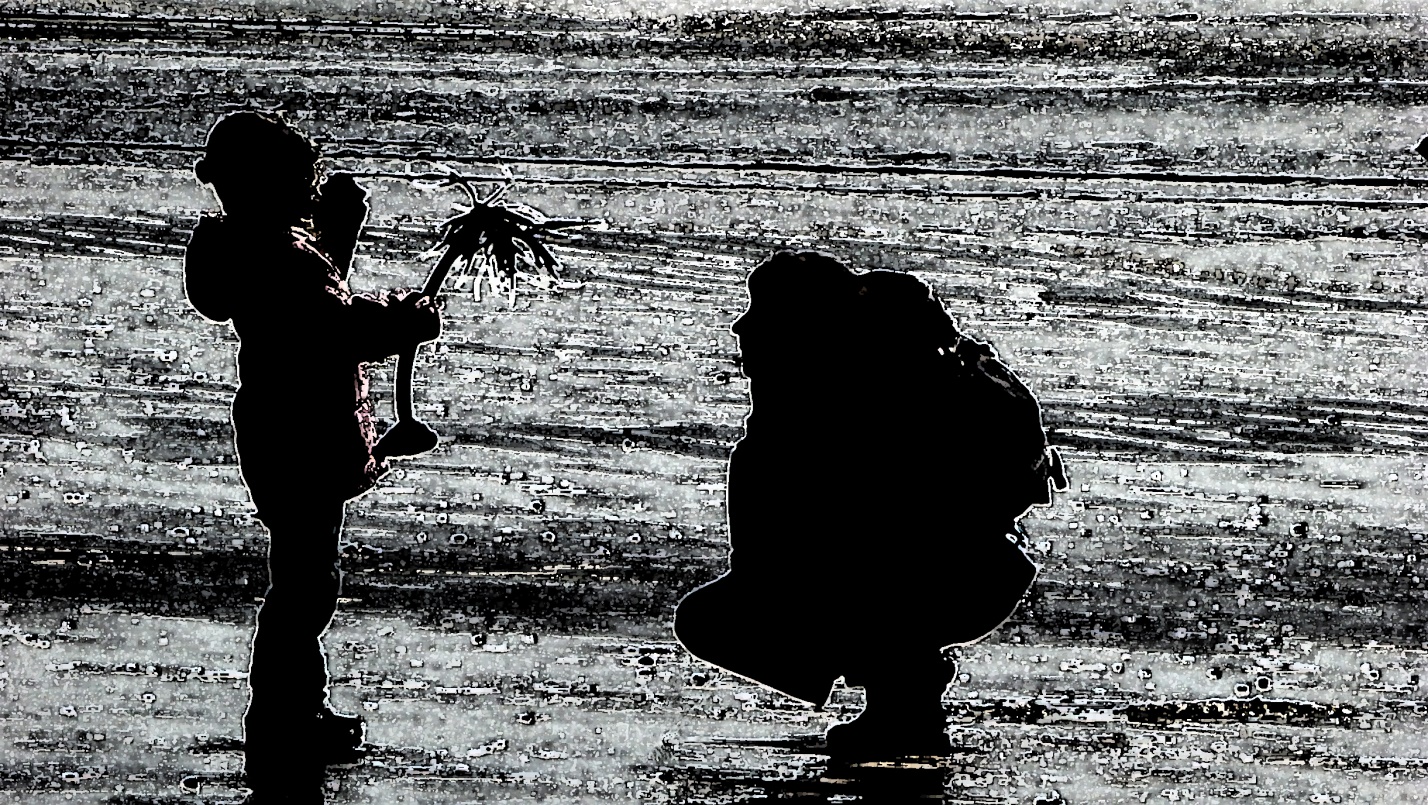
Figure 8: A child presents her beachcombing “find” to an interested adult. At certain seasons Postelsia palmaeformis can be found torn completely away from its habitat – entire little ‘palm trees’ that wash ashore on surf swept coastlines. Chesterman Beach, outer coast, Vancouver Island, BC, Canada. October 18, 2008. Photo ID 27188 ©Seaweedwhisperings.com
![]()